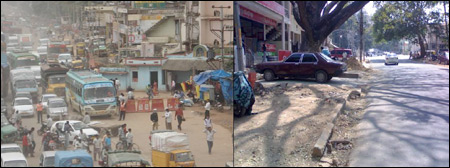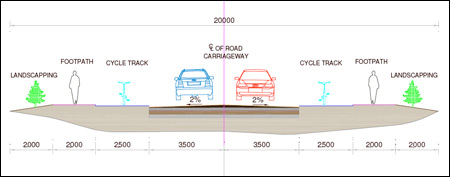Transportation is becoming increasingly difficult in the Indian city of Bangalore. With motorized vehicles taking over much of the city's transportation mode share, the congested city needs to follow the examples of many other world cities and design its roads to be more bicycle- and pedestrian-friendly.
 In auto-centric countries and cities, there is a normal tendency to discriminate against bicycles as a mode of transport. Bangalore, India, has become an auto-centric city, and boasts approximately 6.8 million trips daily. Urban sprawl in recent years has increased the length of these trips, resulting in a decreased mode share of non-motorized transport and public transportation, and an increase in private automobiles.
In auto-centric countries and cities, there is a normal tendency to discriminate against bicycles as a mode of transport. Bangalore, India, has become an auto-centric city, and boasts approximately 6.8 million trips daily. Urban sprawl in recent years has increased the length of these trips, resulting in a decreased mode share of non-motorized transport and public transportation, and an increase in private automobiles.
Many believe that the source of the city's congestion problem is insufficient roads. But the question is can any city build its way out of congestion? Bangalore adds nearly 900 vehicles per day to its roads. With vehicle registrations nearing 3 million in the city, the future looks bleak.
If land use data is analyzed we can conclude that the problem is not insufficient roads, but the priority given to improving vehicular flow rather than improving the movement of people. The transportation share is nearly 20% of Bangalore's land use, which simulates international practice. (It should be noted here that due to inclusion of suburban areas the transportation share dropped from 31% in 2001 to a projected 21% in 2011.)


The root cause for congestion can be known from the fact that motorized vehicles make up about 90% of the total vehicles in the city. Only about 7.5% of vehicles in Bangalore are bicycles, and these account for less than 2% of all person trips.
The Bicyclist: An Endangered Species in Bangalore
Cycling as a mode of transport is virtually non-existent in Bangalore. The city is home to nearly half a million cycles, but this large number of cycles does not translate into trips on roads -- mainly because of the lack of facilities. The low number of bicycles on the road can be explained by the following reasons:
- No Bicycle Lanes – Bangalore has nearly 5922 km of roads, but the standard road cross-section does not include space for bicycle lanes. Roads with cycle tracks have been proposed, but the government has not executed a single cycle track nor released any concrete plans. The lack of interest in this area is illustrated by the fact that the code for cycle tracks has not been updated since 1962. The competition to gain space on the road forces many cyclists to abandon their bikes in favor of the automobile.
- Urban Sprawl – Bangalore's landscape has seen an amazing transformation in recent years with the compact city (174 square kilometers in 1971) exploding into an area of 561 square kilometers. Urban sprawl has caused people to live farther away from their place of work, thereby increasing trip lengths. The average trip length increased from 7.1 km in 2001 to 10.57 km in 2007. With such an increase in trip lengths, the impact on non-motorized transport cannot be ignored.
- High Number of Accidents – Nearly 350 cyclists and pedestrians are killed on roads in Bangalore every year. Exact figures on how many cyclists are killed are not available, but the risks of riding in the city can be gauged from the fact that the nearly 4,500 traffic violations occur every day in Bangalore.
- Social Stigma – In Indian society, cyclists are viewed with contempt while people with flashy automobiles are viewed with awe. This stigma has a big influence on the choice riders make to abandon the cycle in favor of motorized vehicles. The decreasing costs of motorized two-wheelers, zero-interest payment plans provided by banks and catchy advertisements have accelerated the decrease in the mode share of cyclists.

Sustainable Solution: Priority for Bicycles
Bangalore's entire traffic problem can be solved by de-motorization. Provision of footpaths and cycle tracks, in conjunction with and overhaul of the mass transit system would pave the way for a sustainable Bangalore.
The soaring price of fuels, increasing pollution and rising congestion levels are helping to create a political climate that is accepting of bicycle-oriented urban planning. Cities the world over are providing priority to bicycles by improving infrastructure and facilities. In Bangalore, bicycling as a viable mode of transportation must be reinvented and reorganized.
Of all trips taken in the city, 25% are made in range of 1-5 km. Nearly 40% of those trips are made by cars or motorized bikes. By promoting bicycles, the authorities could partially eliminate the motorized share of those short trips.
It is also interesting to note that nearly 60% of the city's roads have a right-of-way greater than 20m. With such wide roads, there is lot of encroachment by hawkers as well as a large amount of dead space which could be transformed into bicycle lanes. The provision of prominent mixed land use further facilitates the use of cycles as a mode of transportation. The creation of secured park-and-ride facilities would also help the public to consider bicycles as feeders to the other modes of transportation.

Bangalore traditionally has been a city with a high public transit usage. The recent reduction in the bus mode share is due to the rapid suburban expansion of the city. This dispersed development pattern reduces the attractiveness of public transportation usage. By rethinking the public transit system and providing park-and-ride facilities, the city could help boost that bus mode share back to its formerly high rate.
As other world cities have begun to do, the government of Bangalore could work with private organizations to initiate a city bike system. This type of system would cater to captive riders by providing the freedom to travel and also to choice riders by providing the necessary infrastructure. Ideally the government should provide safe, accessible, economical, sustainable and efficient means of transportation for the public. Provision of good cycle facilities would provide the means to such an end.
--- Sudhir is a a Project Engineer (Highways) at Secon Pvt. Ltd, and is a postdoctoral researcher in transportation engineering in Bangalore, India.

Analysis: Cybertruck Fatality Rate Far Exceeds That of Ford Pinto
The Tesla Cybertruck was recalled seven times last year.

National Parks Layoffs Will Cause Communities to Lose Billions
Thousands of essential park workers were laid off this week, just before the busy spring break season.

Retro-silient?: America’s First “Eco-burb,” The Woodlands Turns 50
A master-planned community north of Houston offers lessons on green infrastructure and resilient design, but falls short of its founder’s lofty affordability and walkability goals.

Test News Post 1
This is a summary

Analysis: Cybertruck Fatality Rate Far Exceeds That of Ford Pinto
The Tesla Cybertruck was recalled seven times last year.

Test News Headline 46
Test for the image on the front page.
Urban Design for Planners 1: Software Tools
This six-course series explores essential urban design concepts using open source software and equips planners with the tools they need to participate fully in the urban design process.
Planning for Universal Design
Learn the tools for implementing Universal Design in planning regulations.
EMC Planning Group, Inc.
Planetizen
Planetizen
Mpact (formerly Rail~Volution)
Great Falls Development Authority, Inc.
HUDs Office of Policy Development and Research
NYU Wagner Graduate School of Public Service

























